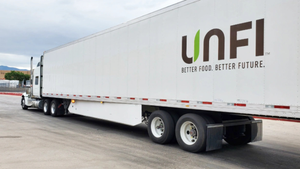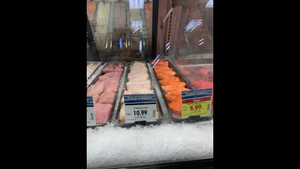Fill-In Markets Seen as Opportunity for Kroger
“We frankly think our operating model is better than many of the operating models that we may be able to acquire.” — Michael Schlotman, chief financial officer, Kroger
CINCINNATI — Where will Kroger wind up next?
The company announced earlier this month that it would look to new markets and invest in “fill-in” markets for expansion as part of an increased capital spending budget designed to boost its growth rate. Although the company did not reveal specific plans for that growth, an examination of Kroger’s recent investments — in context with recent comments from its executives — gives an indication of the kinds of places Kroger has found attractive.
These markets include Richmond, Va., where Kroger recently completed a three-year expansion plan including multiple store renovations, new stores and the introduction of its first Marketplace multi-department store; and a more recent announcement that it would grow share in Virginia Beach. The latter market will see some $250 million invested over the next five years for 10 new stores, including the region’s first Marketplace store, Kroger officials said.
Both Richmond (prior to the investment), and Virginia Beach (currently) are what Kroger refers to as “secondary markets” where the company operates fewer than nine stores. Kroger did not rank No. 1 or No. 2 in market share in either market, according to Kroger’s 2011 Fact Book.
 The appeal for investing in such markets is the opportunity to improve returns over a long period as new stores mature, Rodney McMullen, Kroger’s chief operating officer, explained during the company’s analyst day meeting earlier this month. Comparing a market where Kroger has leading share to a “fill-in” market identified by meeting attendees as Richmond,
The appeal for investing in such markets is the opportunity to improve returns over a long period as new stores mature, Rodney McMullen, Kroger’s chief operating officer, explained during the company’s analyst day meeting earlier this month. Comparing a market where Kroger has leading share to a “fill-in” market identified by meeting attendees as Richmond,
McMullen noted the opportunity to grow was evident in the percentage of the population that lives near a Kroger store. In the example McMullen provided, 67% of the population of the leading market lives within two miles of Kroger store, and 83% live within three miles. In Richmond, those figures are 32% and 54%, respectively.
“So you can see there is a tremendous amount of opportunity in this market to improve share, and we believe that over time, there is a tremendous opportunity to improve returns as these assets mature,” McMullen said. Although new Kroger stores typically do not make money during their first year, McMullen added, their returns improve for five to seven years.
McMullen said Kroger operates in as many as 30 markets that resemble Richmond in terms of their potential for similar growth. He said the company would be selective as to which markets would get such investments, but acknowledged that the incremental increases in capital spending by Kroger in coming years would be “very targeted” toward these fill-in opportunities as well as new stores.
Market Opportunities
Using data from Kroger’s 2011 Fact Book, markets that resemble Richmond and Virginia Beach could include Raleigh, N.C.; Durham, N.C.; Boise, Idaho; and Omaha, Neb. Company officials did not return calls seeking comment.
Industry observers said they see Kroger’s biggest opportunity could be in Chicago, where the retailer currently has a slim 2% market share behind its Food 4 Less discount concept and a potential to grow through acquisition of Supervalu’s Jewel chain.
Kroger, however, has maintained a lukewarm posture on acquiring stores. “We frankly think our operating model is better than many of the operating models that we may be able to acquire,” Michael Schlotman, Kroger’s chief financial officer, said earlier this month.
Burt P. Flickinger III, managing partner at Strategic Resource Group, New York, said he felt that Kroger’s success at Food 4 Less could be replicated in new and existing markets.
“They seem to have had a real breakthrough in Indiana and Illinois with Food 4 Less,” Flickinger said. “I could see them expanding more in those areas, where some Food 4 Less stores are doing the kind of volume on a weekend that Wal-Mart is doing.”
Kroger’s plan for new markets is modest — officials said they would enter “a couple” of new territories over the next few years, likely leading with its Marketplace store. The company ruled out expanding in markets where it couldn’t use existing infrastucture, so expansion would be to adjacent markets.
Kroger officials added that they were studying markets where Kroger’s offering would best fit local consumer preferences. It is worth noting that its Richmond growth accompanied the sale and banner transition of traditional market leader Ukrop’s Super Markets. The Virginia Beach market is also in flux as its leader, Farm Fresh, absorbs the uncertainty at parent Supervalu.
Flickinger said he believes Kroger would look to places like northern Ohio and western Michigan for new stores. “There’s a chance to grow that whole Great Lakes region,” he said. He also said there was an opportunity in Utah and Arizona for Kroger to strengthen its positioning with new investment.
More news: Kroger Names Perry, Ellis to New Posts
Chuck Cerankosky, an analyst following Kroger for Northcoast Research in Cleveland, said he would not rule out Cleveland. “There’s speculation that another large chain could be in this in this market, and Kroger operates in Toledo and Columbus, which aren’t too far away,” Cerankosky told SN. He added, however, that a “the right acquisition would be the most efficient way” for Kroger to grow.
The strategy for targeting investment in specific markets follows a strategic shift detailed earlier this year whereby Kroger changed its process of allocating capital. Instead of giving its various divisions capital to spend, it shifted to a process that directs investment toward projects with the best potential for return despite their location.
Schlotman said the company has “a reasonable chance” of growing its overall� square footage this year.
About the Author
You May Also Like








